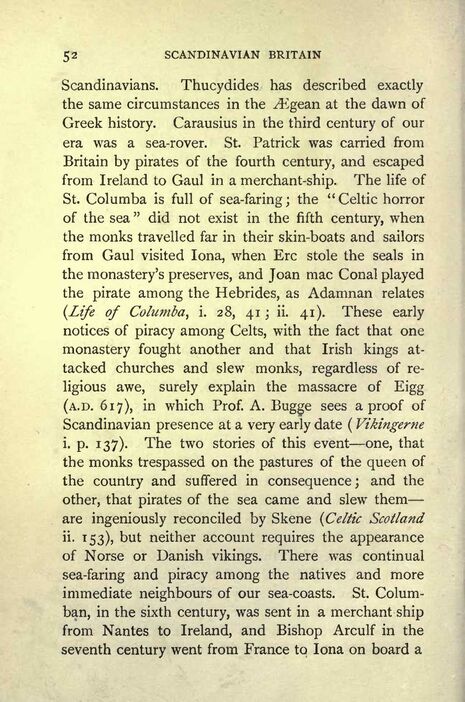
Full resolution (JPEG) - On this page / på denna sida - Scandinavian Britain - I. The Earlies Raids

<< prev. page << föreg. sida << >> nästa sida >> next page >>
Below is the raw OCR text
from the above scanned image.
Do you see an error? Proofread the page now!
Här nedan syns maskintolkade texten från faksimilbilden ovan.
Ser du något fel? Korrekturläs sidan nu!
This page has been proofread at least once.
(diff)
(history)
Denna sida har korrekturlästs minst en gång.
(skillnad)
(historik)
Scandinavians. Thucydides has described exactly
the same circumstances in the Ægean at the dawn of
Greek history. Carausius in the third century of our
era was a sea-rover. St. Patrick was carried from
Britain by pirates of the fourth century, and escaped
from Ireland to Gaul in a merchant-ship. The life of
St. Columba is full of sea-faring; the "Celtic horror
of the sea" did not exist in the fifth century, when
the monks travelled far in their skin-boats and sailors
from Gaul visited Iona, when Erc stole the seals in
the monastery’s preserves, and Joan mac Conal played
the pirate among the Hebrides, as Adamnan relates
(Life of Columba, i. 28, 41; ii. 41). These early
notices of piracy among Celts, with the fact that one
monastery fought another and that Irish kings
attacked churches and slew monks, regardless of
religious awe, surely explain the massacre of Eigg
(A.D. 617), in which Prof. A. Bugge sees a proof of
Scandinavian presence at a very early date (Vikingerne
i. p. 137). The two stories of this event–one, that
the monks trespassed on the pastures of the queen of
the country and suffered in consequence; and the
other, that pirates of the sea came and slew them–
are ingeniously reconciled by Skene (Celtic Scotland
ii. 153), but neither account requires the appearance
of Norse or Danish vikings. There was continual
sea-faring and piracy among the natives and more
immediate neighbours of our sea-coasts. St.
Columban, in the sixth century, was sent in a merchant ship
from Nantes to Ireland, and Bishop Arculf in the
seventh century went from France to Iona on board a
<< prev. page << föreg. sida << >> nästa sida >> next page >>